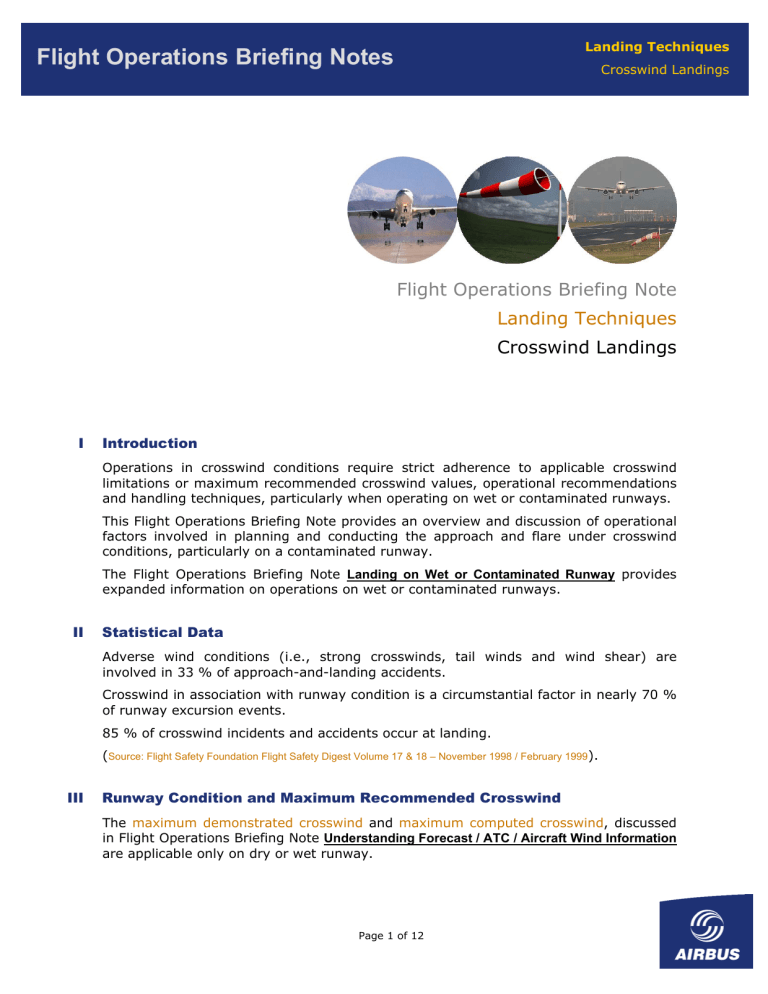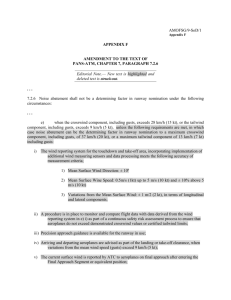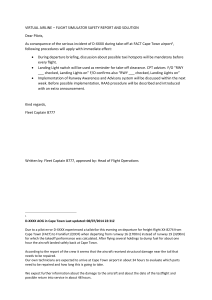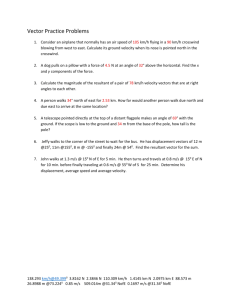
Landing Techniques Flight Operations Briefing Notes Crosswind Landings Flight Operations Briefing Note Landing Techniques Crosswind Landings I Introduction Operations in crosswind conditions require strict adherence to applicable crosswind limitations or maximum recommended crosswind values, operational recommendations and handling techniques, particularly when operating on wet or contaminated runways. This Flight Operations Briefing Note provides an overview and discussion of operational factors involved in planning and conducting the approach and flare under crosswind conditions, particularly on a contaminated runway. The Flight Operations Briefing Note Landing on Wet or Contaminated Runway provides expanded information on operations on wet or contaminated runways. II Statistical Data Adverse wind conditions (i.e., strong crosswinds, tail winds and wind shear) are involved in 33 % of approach-and-landing accidents. Crosswind in association with runway condition is a circumstantial factor in nearly 70 % of runway excursion events. 85 % of crosswind incidents and accidents occur at landing. (Source: Flight Safety Foundation Flight Safety Digest Volume 17 & 18 – November 1998 / February 1999). III Runway Condition and Maximum Recommended Crosswind The maximum demonstrated crosswind and maximum computed crosswind, discussed in Flight Operations Briefing Note Understanding Forecast / ATC / Aircraft Wind Information are applicable only on dry or wet runway. Page 1 of 12 Landing Techniques Flight Operations Briefing Notes Crosswind Landings On a runway contaminated with standing water, slush, snow or ice, a maximum recommended crosswind is defined (Table 1), depending on: • Reported braking action (if available), or • Reported runway friction coefficient (if available), or • Equivalent runway condition (if braking action and runway friction coefficient are not available). Reported Reported Equivalent Maximum Braking Action (Index) Runway Friction Runway Recommended Coefficient Condition Crosswind Good (5) 0.40 and above Note 1 Max demonstrated Good / Medium (4) 0.36 to 0.39 Note 1 30 kt Medium (3) 0.30 to 0.35 Note 2 and Note 3 25 kt Medium / Poor (2) 0.26 to 0.29 Note 2 and Note 3 20 kt Poor (1) 0.25 and below Note 3 and Note 4 15 kt Unreliable (9) Unreliable Note 4 and Note 5 5 kt Table 1 Maximum Recommended Crosswind - Typical The Equivalent Runway Condition, defined by Note 1 through Note 5, can be used only for the determination of the maximum recommended crosswind. This Equivalent Runway Condition cannot be used for the computation of takeoff and landing performance, because it does not account for the effects of the displacement drag and impingement drag (as defined in the Flight Operations Briefing Note Landing on Wet or Contaminated Runway). Note 1: Dry or wet runway without risk of hydroplaning. Note 2: Runway covered with slush. Note 3: Runway covered with dry snow. Note 4: Runway covered with standing water, with risk of hydroplaning, or with wet snow. Note 5: Runway with high risk of hydroplaning. Page 2 of 12 Landing Techniques Flight Operations Briefing Notes Crosswind Landings The maximum recommended crosswind on a contaminated runway is based on computation rather than flight tests, but the calculated values are adjusted in a conservative manner based on operational experience. Some operators consider reduced maximum crosswind values when the first officer is PF, during line training and initial line operation. The maximum crosswind for performing an autoland is a certified limitation. Assignment by ATC of a given landing runway should be questioned by the PF if prevailing runway conditions and crosswind component are considered inadequate for a safe landing. Final Approach Technique Figure 1 shows that depending on the recommendations published in the aircraftoperating manual, the final approach under crosswind conditions may be conducted: • With wings-level (i.e., applying a drift correction in order to track the runway centerline, this type of approach is called a crabbed approach [Airbus recommended technique]), or • With a steady sideslip (i.e., with the aircraft fuselage aligned with the runway centerline, using a combination of into-wind aileron and opposite rudder to correct the drift). [Airbus recommended technique] IV Crabbed Approach Sideslip Approach Figure 1 Crabbed Approach versus Sideslip Approach Page 3 of 12 Flight Operations Briefing Notes Landing Techniques Crosswind Landings Airframe manufacturers consider the following factors when recommending a wingslevel or a steady-side-slip approach: • Aircraft geometry (i.e., pitch attitude and bank angle limits for preventing tail strike, engine nacelle contact or wingtip contact) • Ailerons (roll) and rudder (yaw) authority • Crosswind component. This Flight Operations Briefing Note focus on the wings-level / crabbed approach technique, recommended by Airbus, to discuss the associated flare and decrab techniques depending on the crosswind component. V Flare Technique The objectives of the lateral control of the aircraft during the flare are to land on the centerline, and to minimize the loads on the main landing gear. During the flare, rudder should be applied as required to align the aircraft with the runway heading. Any tendency to roll downwind should be counteracted by an appropriate input on the sidestick (or control column, as applicable). In the case of a very strong crosswind, the aircraft may be landed with a residual drift / crab angle (maximum 5°) to prevent an excessive bank (maximum 5°). Consequently, combination of the partial decrab and wing down techniques may be required. VI Understanding Crosswind Landing Limitations The following discussion of flight dynamics can provide an enhanced understanding of the various crosswind landing techniques (i.e., final approach, flare and align phases). Crosswind Landing Capability – Design Factors Figures 2 and Figure 3 illustrate the limitations involved in crosswind landing (for a given steady crosswind component): • Bank angle at a given crab angle or crab angle at a given bank angle: − • The graph provides the bank angle / crab angle relationship required to correct the drift and track the runway centerline at the final approach speed (VAPP) in a steady-side-slip condition. Positive crab angles reflect normal drift corrections and sideslip conditions (i.e., with the aircraft pointing into wind). Negative crab angles result from an excessive rudder correction (i.e., aircraft pointing away from wind direction) and require a more-than-desired bank angle to maintain a steady-sideslip. Aircraft geometry limitation: − This limitation reflects the maximum pitch attitude and/or bank angle that can be achieved without incurring a tail strike or scrapping the engine nacelle, the flaps or the wingtip (as applicable). Page 4 of 12 Landing Techniques Flight Operations Briefing Notes • Crosswind Landings Ailerons / rudder authority: − This limitation reflects the aircraft maximum capability to maintain a steadysideslip under crosswind conditions. Figure 2 and Figure 3 assume that the approach is stabilized and that the flare is performed at a normal height and with a normal pitch rate. These figures may not be available and published for all aircraft types and models, but all aircraft are subject to the same basic laws of flight dynamics that these figures reflect. Geometry limits usually are not a concern in high crosswinds as the roll and rudder authority is reached before any aircraft-to-ground contact occurs. This assumes achieving a steady sideslip without overcontrol (i.e., without excessive rudder and roll inputs) during the decrab / align phase. Figure 2 shows that with a 10 kt steady crosswind component: • Achieving a steady sideslip landing (i.e., with zero crab angle [point A]) requires only a 3-degree into-wing bank angle; or, • Achieving a wings level touchdown (i.e., with no decrab [point B]) only requires a 4-degree to 5-degree crab angle at touchdown. Crab Angle (Degree) A steady-sideslip landing can be performed safely (i.e., while retaining significant margins relative to geometry or roll / rudder limits). 12 10 8 6 4 B X 2 0 AX 0 Degree Bank-Angle 2 Degree 4 Degree 6 Degree 8 Degree 10 Degree 12 Degree -2 -4 -6 -8 -10 -12 -14 115 Roll / Rudder Limit Geometry Limit 120 130 VAPP 140 150 160 Indicated Airspeed (kt) Figure 2 Crab Angle versus Bank Angle Typical - Maximum Landing Weight - Landing Configuration - 10 kt Crosswind Page 5 of 12 Landing Techniques Flight Operations Briefing Notes Crosswind Landings Figure 3 shows that with a 30 kt steady crosswind component: • Achieving a steady-sideslip landing (i.e., with zero crab angle [point A]) requires nearly a 9-degree into-wind bank angle, placing the aircraft closer to its geometry and roll /rudder limits. • Achieving a wings-level touchdown (i.e., with no decrab [point B]) would result in a 13-degree crab angle at touchdown, potentially resulting in landing gear damage. With 30 kt crosswind, adopting a combination of sideslip and crab angle (i.e., moving from point A to point C) restores significant margins relative to geometry and roll/rudder limits while eliminating the risk of landing gear damage. This requires, typically: • 5 degrees of crab angle, and • 5 degrees of bank angle. On aircraft models limited by their geometry characteristics, increasing the final approach speed (i.e., by applying a wind correction on the final approach speed, even under full crosswind, thus moving from point A to point D) increases the margin with respect to the geometry limitation. Crab Angle (Degree) 16 14 B 12 X 0 Degree Bank-Angle 2 Degree 4 Degree 6 Degree 8 Degree 10 Degree 12 Degree 10 8 6 CX 4 2 0 AX XD -2 -4 -6 Roll / Rudder Limit Geometry Limit -8 -10 -12 -14 115 120 130 VAPP 140 150 160 Indicated Airspeed (kt) Figure 3 Crab Angle versus Bank Angle Typical - Maximum Landing Weight - Landing Configuration - 30 kt Crosswind Page 6 of 12 Flight Operations Briefing Notes Landing Techniques Crosswind Landings Operational Recommendations and Handling Techniques Figure 2 and Figure 3 show that: • With low crosswind (typically up to 15 kt to 20 kt crosswind component), a safe crosswind landing (i.e., flare and touchdown) can be performed with either: − A steady-sideslip (i.e., no crab angle), or − Wings-level with no decrab prior to touchdown. Note [Airbus recommended technique]: During the flare, rudder should be applied as required to align the aircraft with the runway heading. Any tendency to roll downwind should be counteracted by an appropriate input on the sidestick (or control column, as applicable). • With higher crosswind (typically above 15 kt to 20 kt crosswind component), a safe crosswind landing requires: − A crabbed-approach, and − A partial decrab prior to touchdown, using a combination of bank angle and crab angle (achieved by applying cross-controls). On most Airbus models, this requires touching down with: VII − Maximum 5 degrees of crab angle, and − Maximum 5 degrees of bank angle. Understanding Touchdown and Rollout Touchdown – Friction Forces Upon touchdown of the main landing gear, the aircraft transitions from the “ laws of flight dynamics” to the “ laws of ground dynamics”. The following are among the events that occur upon touchdown: • Wheels rotation, unless hydroplaning is experienced. To minimize the risk of hydroplaning and ensure a positive spin up of wheels, it is recommended to perform a firm touchdown when landing on a contaminated runway. • Buildup of friction forces between the wheel tires and the runway surface (Figure 4), under the combined effect of: − Wheels/tires-braking forces; and, − Tire-cornering forces. Page 7 of 12 Landing Techniques Flight Operations Briefing Notes Crosswind Landings Crab Angle X-Wind Aircraft Motion Tire Cornering Force X-Wind Force Tire Braking Force Figure 4 Friction forces between the wheel and the runway Wheels/tires-braking forces and tires-cornering forces depend on the tire and runway conditions but also on each other, the higher the braking force, the lower the cornering force, as illustrated by Figure 5. 100 90 Anti skid activation 80 Forces (%) 70 60 50 Braking Force 40 Cornering Force 30 20 10 Free rolling wheel Slip Ratio (%) 10 0 90 80 70 60 50 40 30 20 10 0 0 Blocked wheel Figure 5 Tire Braking and Cornering Forces Transient effects such as the distortion of the tire thread (caused by any yawing movement of the wheel) or the activation of the anti-skid system affect the tire- Page 8 of 12 Flight Operations Briefing Notes Landing Techniques Crosswind Landings cornering and wheel-braking forces (in both magnitude and direction) and, thus, affect the overall balance of friction forces. As a consequence, the ideal balance of forces illustrated by Figure 4 is rarely steadily maintained during the initial landing roll. Effect of Touchdown on Alignment When touching down with some crab angle on a dry runway, the aircraft automatically realigns with the direction of travel down the runway. On a contaminated runway, the aircraft tends to travel along the runway centerline with the existing crab angle. Effect of Fuselage and Fin Side Force As the aircraft touches down, the side force created by the crosswind component on the fuselage and fin tends to make the aircraft skid sideways (downwind) off the centerline, as illustrated by Figure 6. Effect of Thrust Reversers When selecting reverse thrust with some crab angle, the reverse thrust results into two force components, as illustrated by Figure 6: • A stopping force aligned along the aircraft direction of travel (runway centerline), and • A side force, perpendicular to the runway centerline, which further increases the tendency to skid sideways. Crosswind component Touchdown with partial decrab Aircraft skidding sideways tendancy increased by reverse thrust side force Reverse cancelled and brakes released Directional control and centerline regained Figure 6 Directional Control during Crosswind Landing Page 9 of 12 Reverse thrust and pedal braking reapplied Flight Operations Briefing Notes Landing Techniques Crosswind Landings The thrust reverser effect decreases with decreasing airspeed. As airspeed decreases, the rudder efficiency decreases and is further affected by the airflow disruption created in the wake of the engine reverse flow, possibly resulting in difficulties to maintain directional control. Handling Techniques to Maintain / Regain Directional Control The higher the wheel/tire braking force, the lower the tire-cornering force; therefore, if the aircraft tends to skid sideways, releasing the brakes (i.e., by taking over from the autobrake) increases the tire-cornering and contributes to maintaining or regaining directional control (Figure 6). Selecting reverse idle cancels the effects of reverse thrust (i.e., the side force and rudder airflow disruption) and, thus, further assists in regaining directional control. After directional control has been recovered and the runway centerline has been regained: • Pedal braking can be applied (autobrake was previously disarmed when taking over) in a symmetrical or differential manner, as required, and • Reverse thrust can be reselected. Effect of Braking In a high crosswind, cross-controls may have to be maintained after touchdown to prevent the into-wind wing from lifting and to counteract the weathercock effect (some flight crew training manuals adequately state that the pilot should continue to fly the aircraft during the landing roll). However, into-wind aileron decreases the lift on the into-wind wing, thus resulting in an increased load on the into-wind landing gear. Because the friction force increases as higher loads are applied on the wheels and tires, the braking force increases on the into-wind landing gear, creating an additional tendency to turn into-wind, as illustrated by Figure 7. Figure 7 Effect of Uneven MLG Loads on Braking Page 10 of 12 Flight Operations Briefing Notes Landing Techniques Crosswind Landings When the runway contaminant is not evenly distributed, the antiskid system may release the brakes on one side only. Note: Recommendations about optimum braking techniques are given in the Flight Operations Briefing Note Optimum Use of Braking Devices. VIII Factors Involved in Crosswind-Landing Incidents and Accidents The following factors often are involved in crosswind-landing incidents and accidents: IX • Failure to recognize changes in landing data over time (i.e., wind direction shift, wind velocity or gust increase) • Reluctance to divert to an airport with less crosswind conditions • Low visibility, that makes runway alignment at touchdown more difficult • Lack of time to observe, evaluate and control the aircraft attitude and flight path in a highly dynamic situation • Wet or contaminated runways. Summary of Key Points Adherence to the following key points increases safety during crosswind-landing operations: • Understand all applicable operating factors, maximum recommended values and limitations; • Use recommended and published flying techniques associated with crosswind landing; • Request the assignment of a more favorable runway, if prevailing runway conditions and crosswind component are considered inadequate for a safe landing; • Adapt the autopilot disconnect altitude to prevailing conditions in order to have time to establish manual control and trim the aircraft (as applicable) before the align / decrab phase and flare; • Be alert to detect changes in ATIS and tower messages (i.e., wind direction shift, velocity and/or gust increase); and, • Beware of small-scale local effects associated with strong winds: − Updrafts and downdrafts; − Vortices created by buildings, forests or terrain. Page 11 of 12 Flight Operations Briefing Notes X Landing Techniques Crosswind Landings Associated Flight Operations Briefing Notes The following Flight Operations Briefing Notes complement the above information: XI XII • Factors Affecting the Final Approach Speed ( V APP ) • Optimum Use of Braking Devices • Landing on Wet and Contaminated Runway • Understanding Forecast / ATC / Aircraft Wind Information Airbus References • Flight Manuals – Performance – General – Maximum Demonstrated Crosswind at Landing • Flight Crew Operating Manuals (FCOMs) – Operating Limitations – General Limitations – Airport Limitations • A300/A310/A300-600 FCOMs – Procedures and Techniques – Inclement Weather Operations - Crosswind • A300/A310/A300-600 FCOM Bulletins – Crosswind Landing Techniques • A320 Family & A330/A340 Family & A380 FCTMs – Landing – Flare – Crosswind Conditions Regulatory References • ICAO – Preparation of an Operations Manual (Doc 9376) • JAR-OPS 1.1045 – Operations manual – structure and contents This Flight Operations Briefing Note (FOBN) has been adapted from the corresponding ALAR Briefing Note developed by Airbus in the frame of the Approach-and-Landing Accident Reduction (ALAR) international task force led by the Flight Safety Foundation. This FOBN is part of a set of Flight Operations Briefing Notes that provide an overview of the applicable standards, flying techniques and best practices, operational and human factors, suggested company prevention strategies and personal lines-of-defense related to major threats and hazards to flight operations safety. This FOBN is intended to enhance the reader's flight safety awareness but it shall not supersede the applicable regulations and the Airbus or airline's operational documentation; should any deviation appear between this FOBN and the Airbus or airline’s AFM / (M)MEL / FCOM / QRH / FCTM, the latter shall prevail at all times. In the interest of aviation safety, this FOBN may be reproduced in whole or in part - in all media - or translated; any use of this FOBN shall not modify its contents or alter an excerpt from its original context. Any commercial use is strictly excluded. All uses shall credit Airbus and the Flight Safety Foundation. Airbus shall have no liability or responsibility for the use of this FOBN, the correctness of the duplication, adaptation or translation and for the updating and revision of any duplicated version. Airbus Customer Services Flight Operations Support and Services 1 Rond Point Maurice Bellonte - 31707 BLAGNAC CEDEX France FOBN Reference : FLT_OPS – LAND – SEQ 05 – REV 03 – MAR. 2008 Page 12 of 12




